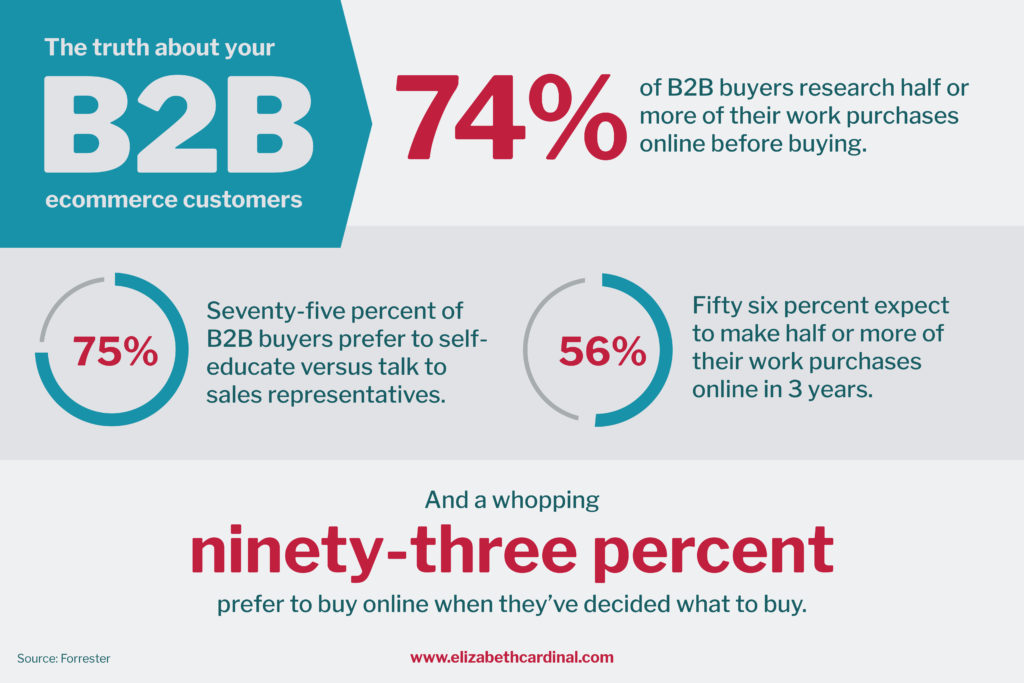First, a few statistics.

74% of B2B buyers research half or more of their work purchases online before buying.
75% of B2B buyers prefer to self-educate versus talk to sales representatives.
56% expect to make half or more of their work purchases online in 3 years.
93% prefer to buy online when they’ve decided what to buy.
Why then, do you keep printing that annual catalog? Is it because your customer is used to ordering that way? That doesn’t mean he likes using it.
And this isn’t just about Millennials, “young people” or [insert other stereotype here]. You may assume that Millennials spend the most money online, followed by Gen X and Baby Boomers. However, the data pattern is quite literally the opposite.
Average online order value in the United States by generation
Baby Boomers – $203 USD
Generation X – $190 USD
Millennials – $173 USD
You may say, “Our products don’t lend themselves to ecommerce.” Maybe that’s true, or maybe there’s another way to look at this. Perhaps your customers won’t buy your core products online (although, most likely, they will), but what about the rest of your products?
I recently talked with a company who sells industrial batteries. On average, each battery costs about $6,000, and orders of 100-300 batteries are common. Because this is a $600,000 to $1,800,000 purchase, a customer may want to make this purchase in a more traditional way, via a purchase order. However, that same customer wants to research these items online before committing to purchase. Maybe she needs information, or to create a quote. Remember that an ecommerce-type experience does not always have to equal “Add to cart”. It’s purely another sales channel to encourage and inform your customers, such that they ultimately convert with your company.
Additionally, what about all the smaller items B2B businesses sell? Businesses who sell parts and supplies lend themselves very well to ecommerce. Additionally, does your company offer some kind of maintenance? If so, that lends itself well to a subscription model, complete with convenient online scheduling. So yes, your customers have needs and goals that you can fulfill through an online transaction. Make it easy for them to do that, and you will reap the rewards.
B2B vs B2C Trends in Sales
Although more effort is being made to improve the user experience of B2C sites, buyer spending on B2B is already significantly higher, and is predicted to keep growing.
According to Forrester:
B2B spending
2019 – $1.1 trillion (predicted)
2013 – $780 billion
B2C spending
2019 – $480 billion (predicted)
2013 – $334 billion
Also according to Forrester, manufacturers and wholesalers represent the majority of this market growth. This is likely due to their reliance on legacy systems with poor user experiences. The manufacturing and wholesale companies who notice and rectify this have the most to gain from improving their sites.
Many B2B companies have grown their businesses by nurturing long-term, personal relationships with their customers. Historically, this has been the most effective way of preventing those customers from going to a competitor. Although this strategy has worked in the past, expectations are shifting as more of the population becomes accustomed to the ease and convenience of shopping online.
Ecommerce retailers, predominantly in the B2C space, are continuously ditching the catalog and focusing on improving their online customer experience. As a result, customers’ expectations of the ease by which they can shop not only that company’s website, but all websites, is increasing exponentially.
B2B businesses are lagging behind in this trend, and not for good reason. They may think that their customers don’t want to buy online, or maybe they simply don’t know where to start in improving their online experiences. Regardless of their reason, the future of their businesses rely on their ability to tailor their online experiences to a new set of preferences.
So do us all (and our environment) a favor, and stop printing those catalogs. No one likes them anyway.
Sources:
http://www.ircecontent.com/assets/161/resources/Hoar_Sheldon1.pdf
https://www.forrester.com/report/US+B2B+eCommerce+Will+Hit+12+Trillion+By+2021/-/E-RES136173
https://www.bigcommerce.com/blog/b2b-ecommerce/
http://blogs.forrester.com/andy_hoar/15-04-14-death_of_a_b2b_salesman
http://www.eshopworld.com/news/baby-boomers-spend-online-millennials/
https://assets.kpmg.com/content/dam/kpmg/xx/pdf/2017/01/the-truth-about-online-consumers.pdf